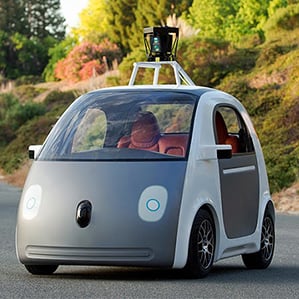Lazy Humans Shaped Google’s New Autonomous Car
The fact that Google’s bubble-like self-driving car, unveiled this week, lacks a steering wheel might be seen as evidence the company’s software is close to mastering the challenges of piloting a vehicle. But the car’s design is just as much a consequence of what Google’s existing fleet of automated Lexus SUVs revealed about human laziness.

Google’s engineers had been focused on perfecting how well those modified cars could handle freeway driving, and they imagined their technology hitting the market in a way that left humans sharing driving duties with their vehicle. “The idea was that the human drives onto the freeway, engages the system, [and] it takes them on the bulk of the trip—the boring part—and then they reëngage,” said Nathaniel Fairfield, a technical lead on the project, speaking at the Embedded Vision Summit in Santa Clara, California, on Thursday.
That approach had to be scrapped after tests showed that human drivers weren’t trustworthy enough to be co-pilots to Google’s software. When people began riding in one of the vehicles, they paid close attention to what the car was doing and to activity on the road around them, which meant the hand-off between person and machine was smooth. But that interest faded to indifference over weeks and months as people became too trusting of the car’s abilities. “Humans are lazy,” says Fairfield. “People go from plausible suspicion to way overconfidence.”
That convinced Google it had to give up on switching between human and machine control, says Fairfield. That also ruled out building on top of conventional car designs, because they assume a human is on hand and ready to take over in the event of an emergency.
“If the car detects there’s something wrong with the power steering, it cuts it out and trusts you,” said Fairfield. “Same with [power-assisted] brakes—they go limp but you can still stop the vehicle.” Google’s tests suggest that anyone accustomed to a self-driving car would be unlikely to be ready take over in the event of such a failure.
And so Google’s new vehicle design takes a leaf out of NASA’s design book to cope with such eventualities. “It doesn’t have a fallback to human—it has redundant systems,” said Fairfield. “It has two steering motors, and we have various ways we can bring it to a stop.”
The car is powered by an electric motor roughly equivalent to that used in the Fiat 500e and has a range of around 100 miles. Its maximum speed is 25 miles per hour to reduce the severity of injuries to pedestrians in the event of a crash, says Fairfield. The front of the vehicle is made of plastic material intended to cushion any impact with a human. Google says it intends to build up a fleet of 100 of the vehicles for testing this summer. However, existing laws mean that only versions that have had conventional controls installed can be tested on public roads.
Fairfield says that the decision to make a purely autonomous vehicle also had the benefit of bringing Google more in line with the company’s original vision of something that could “drive everywhere for everybody.” That more strongly differentiates Google’s approach to automated vehicles from those of conventional automakers, who have pledged to keep humans in ultimate control of their vehicles (see “Driverless Cars Are Further Away Than You Think”).
However, Google’s new focus sets it on a more difficult path to getting its technology into commercial production. The company previously decided to focus on freeway driving because it is a relatively manageable task for software to take on. The new vehicle will have to cope with the much more challenging conditions on urban roads.
Keep Reading
Most Popular
Large language models can do jaw-dropping things. But nobody knows exactly why.
And that's a problem. Figuring it out is one of the biggest scientific puzzles of our time and a crucial step towards controlling more powerful future models.
How scientists traced a mysterious covid case back to six toilets
When wastewater surveillance turns into a hunt for a single infected individual, the ethics get tricky.
The problem with plug-in hybrids? Their drivers.
Plug-in hybrids are often sold as a transition to EVs, but new data from Europe shows we’re still underestimating the emissions they produce.
Google DeepMind’s new generative model makes Super Mario–like games from scratch
Genie learns how to control games by watching hours and hours of video. It could help train next-gen robots too.
Stay connected
Get the latest updates from
MIT Technology Review
Discover special offers, top stories, upcoming events, and more.